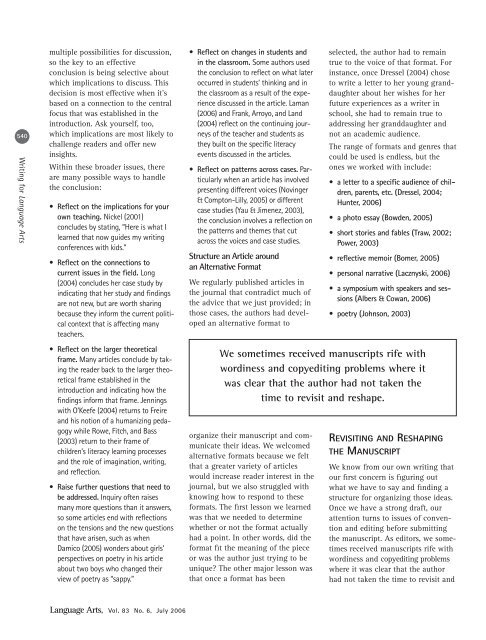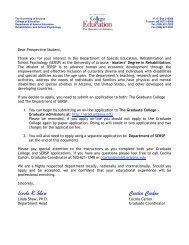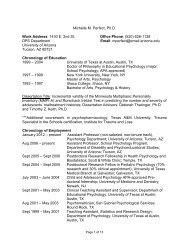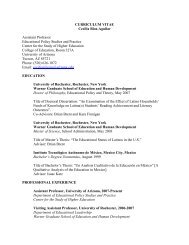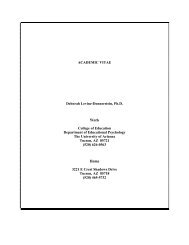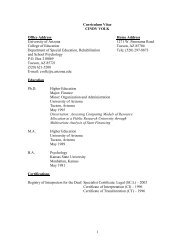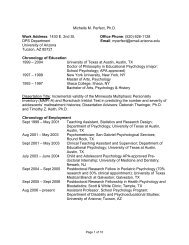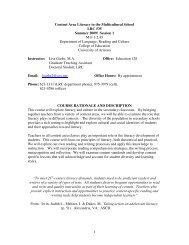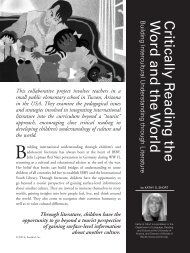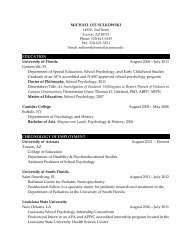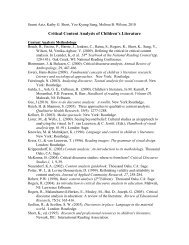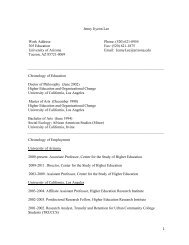Our Reflections on Writing for Publication
Our Reflections on Writing for Publication
Our Reflections on Writing for Publication
You also want an ePaper? Increase the reach of your titles
YUMPU automatically turns print PDFs into web optimized ePapers that Google loves.
540<strong>Writing</strong> <strong>for</strong> Language Artsmultiple possibilities <strong>for</strong> discussi<strong>on</strong>,so the key to an effectivec<strong>on</strong>clusi<strong>on</strong> is being selective aboutwhich implicati<strong>on</strong>s to discuss. Thisdecisi<strong>on</strong> is most effective when it’sbased <strong>on</strong> a c<strong>on</strong>necti<strong>on</strong> to the centralfocus that was established in theintroducti<strong>on</strong>. Ask yourself, too,which implicati<strong>on</strong>s are most likely tochallenge readers and offer newinsights.Within these broader issues, thereare many possible ways to handlethe c<strong>on</strong>clusi<strong>on</strong>:• Reflect <strong>on</strong> the implicati<strong>on</strong>s <strong>for</strong> yourown teaching. Nickel (2001)c<strong>on</strong>cludes by stating, “Here is what Ilearned that now guides my writingc<strong>on</strong>ferences with kids.”• Reflect <strong>on</strong> the c<strong>on</strong>necti<strong>on</strong>s tocurrent issues in the field. L<strong>on</strong>g(2004) c<strong>on</strong>cludes her case study byindicating that her study and findingsare not new, but are worth sharingbecause they in<strong>for</strong>m the current politicalc<strong>on</strong>text that is affecting manyteachers.• Reflect <strong>on</strong> the larger theoreticalframe. Many articles c<strong>on</strong>clude by takingthe reader back to the larger theoreticalframe established in theintroducti<strong>on</strong> and indicating how thefindings in<strong>for</strong>m that frame. Jenningswith O’Keefe (2004) returns to Freireand his noti<strong>on</strong> of a humanizing pedagogywhile Rowe, Fitch, and Bass(2003) return to their frame ofchildren’s literacy learning processesand the role of imaginati<strong>on</strong>, writing,and reflecti<strong>on</strong>.• Raise further questi<strong>on</strong>s that need tobe addressed. Inquiry often raisesmany more questi<strong>on</strong>s than it answers,so some articles end with reflecti<strong>on</strong>s<strong>on</strong> the tensi<strong>on</strong>s and the new questi<strong>on</strong>sthat have arisen, such as whenDamico (2005) w<strong>on</strong>ders about girls’perspectives <strong>on</strong> poetry in his articleabout two boys who changed theirview of poetry as “sappy.”• Reflect <strong>on</strong> changes in students andin the classroom. Some authors usedthe c<strong>on</strong>clusi<strong>on</strong> to reflect <strong>on</strong> what lateroccurred in students’ thinking and inthe classroom as a result of the experiencediscussed in the article. Laman(2006) and Frank, Arroyo, and Land(2004) reflect <strong>on</strong> the c<strong>on</strong>tinuing journeysof the teacher and students asthey built <strong>on</strong> the specific literacyevents discussed in the articles.• Reflect <strong>on</strong> patterns across cases. Particularlywhen an article has involvedpresenting different voices (Novinger& Compt<strong>on</strong>-Lilly, 2005) or differentcase studies (Yau & Jimenez, 2003),the c<strong>on</strong>clusi<strong>on</strong> involves a reflecti<strong>on</strong> <strong>on</strong>the patterns and themes that cutacross the voices and case studies.Structure an Article aroundan Alternative FormatWe regularly published articles inthe journal that c<strong>on</strong>tradict much ofthe advice that we just provided; inthose cases, the authors had developedan alternative <strong>for</strong>mat toorganize their manuscript and communicatetheir ideas. We welcomedalternative <strong>for</strong>mats because we feltthat a greater variety of articleswould increase reader interest in thejournal, but we also struggled withknowing how to resp<strong>on</strong>d to these<strong>for</strong>mats. The first less<strong>on</strong> we learnedwas that we needed to determinewhether or not the <strong>for</strong>mat actuallyhad a point. In other words, did the<strong>for</strong>mat fit the meaning of the pieceor was the author just trying to beunique? The other major less<strong>on</strong> wasthat <strong>on</strong>ce a <strong>for</strong>mat has beenselected, the author had to remaintrue to the voice of that <strong>for</strong>mat. Forinstance, <strong>on</strong>ce Dressel (2004) choseto write a letter to her young granddaughterabout her wishes <strong>for</strong> herfuture experiences as a writer inschool, she had to remain true toaddressing her granddaughter andnot an academic audience.The range of <strong>for</strong>mats and genres thatcould be used is endless, but the<strong>on</strong>es we worked with include:• a letter to a specific audience of children,parents, etc. (Dressel, 2004;Hunter, 2006)• a photo essay (Bowden, 2005)• short stories and fables (Traw, 2002;Power, 2003)• reflective memoir (Bomer, 2005)• pers<strong>on</strong>al narrative (Lacznyski, 2006)• a symposium with speakers and sessi<strong>on</strong>s(Albers & Cowan, 2006)• poetry (Johns<strong>on</strong>, 2003)We sometimes received manuscripts rife withwordiness and copyediting problems where itwas clear that the author had not taken thetime to revisit and reshape.REVISITING AND RESHAPINGTHE MANUSCRIPTWe know from our own writing thatour first c<strong>on</strong>cern is figuring outwhat we have to say and finding astructure <strong>for</strong> organizing those ideas.Once we have a str<strong>on</strong>g draft, ourattenti<strong>on</strong> turns to issues of c<strong>on</strong>venti<strong>on</strong>and editing be<strong>for</strong>e submittingthe manuscript. As editors, we sometimesreceived manuscripts rife withwordiness and copyediting problemswhere it was clear that the authorhad not taken the time to revisit andLanguage Arts, Vol. 83 No. 6, July 2006


